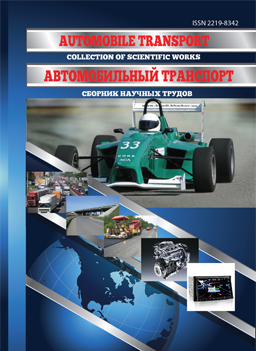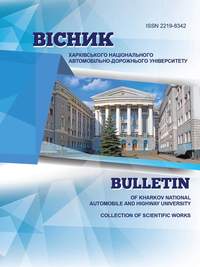The model of friction for dry clutch working process simulation
DOI:
https://doi.org/10.30977/VEIT.2020.18.28Abstract
Problem. Existing models used to reproduce the friction force during mathematical modeling are analyzed in the paper. The urgency of improving such models is shown. Typical problems of existing mathematical models are given. The analysis revealed that most of the models that combine the description of the mode of elastic deformations during the sticking of contact bodies together and the sliding mode with reproduction of the Stribeck effect and hysteresis have many state variables and a significant number of equations and conditions of application of variables. Goal. The goal is to improve complex modern models of friction in terms of reducing state variables and eliminating the drifting effect. Methodology. Methods of research and analysis of information, analytical methods of solving differential equations were used. During the formation of the equations of the mathematical model, the methods of divergence, transformation, convergence and harmonization were used. Results. The paper presents a mathematical model of friction and the logic of its construction. The results of the classic “drift” test for the known friction models and the one proposed for modeling the clutch and its control devices are given in the work. The block diagram of the friction model in Simulink and the simulation results in test modes are also presented to illustrate the reproduction of the model of the Stribek effect and hysteresis in the mode of elastic deformations without sliding of bodies and in the mode of sliding of counter bodies. The principle of combining two modes of modeling laid down in a mathematical model is graphically illustrated. Originality. The proposed system of equations has one state variable - the sliding speed. Additional parameters required to ensure the mode of elastic deformation are determined based on the sliding speed. Practical value. At the end of the work, a comparison of the simulation of the clutch operation using a simple model and an advanced one is given. Emphasis is placed on the possibility of using a single system of equations to simulate the operation of the clutch in the mode of slipping and moving the car and in the mode of further movement without slipping the clutch discs. The reason for stopping the calculation by the solver when using the model of friction with breakpoints is qualitatively shown. The conclusions made give a qualitative and quantitative estimation of the proposed mathematical model of friction and indicate the future steps of its improvement and use.
References
Bataus M., Maciac A., Oprean M., Vasiliu N. Automotive clutch models for real time simulation. (2011). THE PUBLISHING HOUSE OF THEROMANIANACADEMYPROCEEDIN GS OF THEROMANIANACADEMY. Series A. 12 (2). 109–116.
Senatore A., Ruggiero A., Pisaturo M. (2013). Models for pressure control of automated dry clutches: temperature influence on frictional and elastic behaviour. ACTA TECHNICA CORVINIENSIS – Bulletin of Engineering, Tome VI, FASCICULE. 4. 55 – 58.
Andersson S., Soderberg A., Bjorklund S., (2007). Friction models for sliding dry, boundary and mixed lubricated contacts. Tribology International. 40. 580–587.
Karnopp D., (1985). Computer simulation of stick/slip friction in mechanical dynamic systems. Trans. ASME. J. of Dynamic Systems, Measurement and Control. 107. March. 100-103.
Canudas-De-Wit С. (1998). Comments on «A New Model for Control of Systems with Friction. IEEE Transactions on Automatic Control. 43. 8. 1189 – 1190.
Dupont P., Hayward V., Armstrong B., Altpeter F. (2002). Single state elasto-plastic friction models. IEEE transactions on automatic control, 47. 5. 787 – 792.
Kern R. H., Gao C.-T., Nitsche R. (1995). Reibkraftkompensation mittels Fuzzy-Logik Automatisierungstechnischepraxis. 37. 50.
Hlebalin N. A., Kostikov A. YU. (2003). Mo-delirovanie treniya i kompensaciya ego nega-tivnogo vliyaniya v procedure avtomatiziro-vannoj nastrojki reguliruyushchego ustrojstva tekhnologicheskoj mashiny. [Modeling of friction and compensation of its negative influence in the procedure of automated adjustment of the control device of a technological machine.] Tr. mezhdunarod. konf. «Identifikaciya sistem i zadachi upravleniYA» SICPRO’2003. Moskva. IPU RAN, 1821–1849. (ISBN 5-201-14948-0) [in Russian]
Armstrong B. (1995). Challendges to Systematically Engineered Friction Compensation. Proc. of IFAC Workshop on Motion Control. Munich. 21–30.
Kragel'skij I. V., Gitis N. V. (1987). Frik-cionnye avtokolebaniya. [Frictional self-oscillations] Moskva. Nauka. [in Russian]
Solodovnikov V.V. (1967). Tekhnicheskaya kіbernetika. [Technical cybernetics] kn. 3. Moskva. Mashinostroenie. [in Russian]
Hlebalin N. A., Kostikov A. YU., (2000). Biblioteka modelej treniya v Simulink (opyt sozdaniya i ispol'zovaniya). [Library of friction models in Simulink (experience of creation and use)]. Trudy II nauchnoj konferencii «Proektirovanie inzhenernykh i nauchnykh prilozhenij v srede MATLAB». Se-kciya 5. Modelirovanie v Simulink. 1611 – 1633. [in Russian]
Mykhalevych M.H. (2020) Zcheplennia avtotransportnykh zasobiv. Matematychne modeliuvannia ta avtomatyzatsiia [Clutch of vehicles. Mathematical modeling and automation monohrafiia]. Kharkiv. KhNADU. [in Ukraine]
Zakharik YU.M. (2004). Kompleksnyj zakon upravleniya scepleniem. [Complex clutch control principle]. Avtomobil'naya promyshlennost'. 9. 23-25. [in Russian]
Myklebust А. (2014). Dry Clutch Modeling, Estimation, and Control. Doctoral Dissertation. №. 1612. Linköping. Sweden.
Ritter C. S., Valdiero A. C., Andrighetto P. L, Zago F., Endler L. Nonlinear characteristics systematic study in pneumatic actuators. ABCM Symposium Series in Mechatronics. 4. 818 – 826.
Swevers J., Al-Bender F., Ganseman C.G., Prajogo T. (2000). An integrated friction model structure with improved presliding behavior for accurate friction compensation. IEEE Transactions on Automatic Control. 45. 4. 675–686.
Downloads
Published
How to Cite
Issue
Section
License
Copyright (c) 2021 Микола Григорович Михалевич

This work is licensed under a Creative Commons Attribution 4.0 International License.
Автори, які публікуються у цьому журналі, погоджуються з наступними умовами:
1. Автори залишають за собою право на авторство своєї роботи та передають журналу право першої публікації цієї роботи на умовах ліцензії Creative Commons Attribution License, котра дозволяє іншим особам вільно розповсюджувати опубліковану роботу з обов'язковим посиланням на авторів оригінальної роботи та першу публікацію роботи у цьому журналі.
2. Автори мають право укладати самостійні додаткові угоди щодо неексклюзивного розповсюдження роботи у тому вигляді, в якому вона була опублікована цим журналом (наприклад, розміщувати роботу в електронному сховищі установи або публікувати у складі монографії), за умови збереження посилання на першу публікацію роботи у цьому журналі.
3. Політика журналу дозволяє і заохочує розміщення авторами в мережі Інтернет (наприклад, у сховищах установ або на особистих веб-сайтах) рукопису роботи, як до подання цього рукопису до редакції, так і під час його редакційного опрацювання, оскільки це сприяє виникненню продуктивної наукової дискусії та позитивно позначається на оперативності та динаміці цитування опублікованої роботи.








